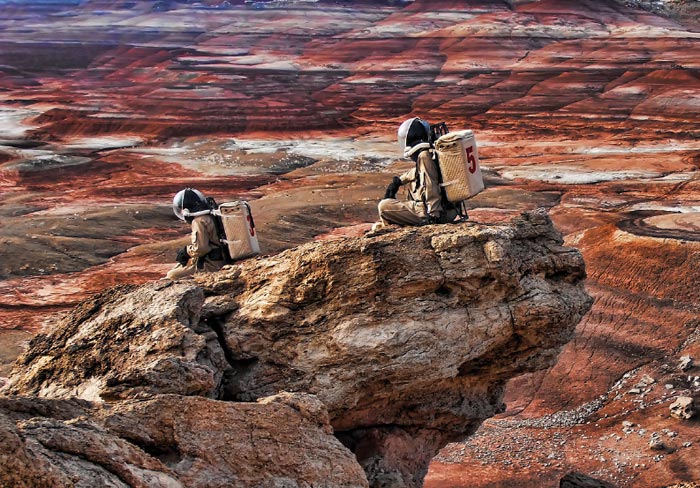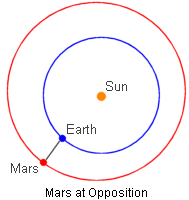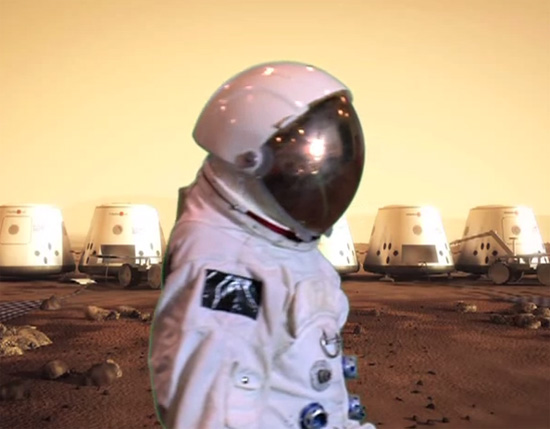April 8, 2014 – If you are a regular visitor to this blog site you have had the opportunity to read about the project dubbed Mars One, an enterprise focused on colonizing the red planet which by the way is in opposition to Earth this week, that is, directly aligned with the Earth and Sun (see diagram below). Mars at its closest to us is better than 55.8 million kilometers (34.6 million miles) away. In this opposition the distance of separation is 92.4 million kilometers (57.4 million miles). That’s a long way to go if you are planning a trip there. And that’s what makes the entire Mars One project more a pipe dream than a near future reality.
The roadmap for Mars One has been well publicized. First, the crew selection, which began last year, has had as many as 200,000 here on Earth apply to take the one-way trip to our planetary neighbor. Training of the first 4 Martian colonists is to begin in 2015. First flight to establish a Deep Space communication link is scheduled for 2016. A robotic mission to select a colony site is scheduled for 2018. A second Deep Space communication link is to be put in place that same year. Then six missions in 2020 are to deliver living modules and life support systems to the colony site where the robotic rover will provide the muscle to get these accommodations in place. In 2021 six additional supply units will be added to prepare the colony for its human inhabitants. The supply units will include the machinery to extract oxygen, water, nitrogen and argon. Then in 2022 the spaceship to take the first Martian colonists will be assembled in low-Earth orbit before the launch and arrival at the Red Planet in 2023.
So why is this a pipe dream and not realizable within the time frame suggested?
Here are some of the problems I see in the Mars One project:
- For humans to succeed in the harsh environment of Mars they must first develop and test closed-system life-support technology. We have yet to demonstrate this capability here on Earth let alone in space or at a remote location such as Mars. I would suggest, therefore, that we need to demonstrate this type of technology in the laboratory right here first, then in low-Earth orbit, and then at a Lagrange Point in Deep Space or in a habitat on the Moon. NASA has dubbed these systems Controlled Ecological Life Support System or CELSS. Right now we are years away from such capability. Think about the complexity. We have to develop a system where we integrate plants to produce food, to do CO2 uptake, to release oxygen, and to purify water. Human waste and excess heat will need to be managed, in part to support the plants in a closed symbiotic relationship. Continuous harvesting to meet food requirements will lead to development of new plant types capable of growing in zero or low-gravity environments. Plants grown in space will thrive in a hydroponic greenhouse. Plants grown on the Moon or Mars will derive nutrients from the local regolith. For the latter we have no idea if the mineral balance will provide a crop yield suitable for human consumption. That’s a big “if.”
- It is one thing to build a Deep Space network for two-way communications between Earth and Mars, it is quite another to maintain it so that the link never goes down. The current Mars One plan lacks the stepping stones of an infrastructure that should be a minimal requirement when establishing human colonies in Deep Space. Back in July of 2012 I wrote a blog that talked about way stations. NASA has been studying the creation of fuel depots in Deep Space. But way stations would be more than this. These would be the service centers for the highway that links Earth to Mars. Service centers would have fuel, oxygen and water, and even food supplies. A network of these between Earth and Mars could even serve as emergency habitats for voyages between the planets. And instead of a human crewed voyage to Mars being a one-way street, the links provided by these way stations would allow traffic to go back and forth. Today we are still in the planning stages to establish the first trial fuel depot in space let alone developing a robust service and supply way station.
- The voyage to Mars itself is problematic for a human crew. The current technology we have deployed in space at the International Space Station (ISS) would be inadequate for a Deep Space voyage between Earth and Mars. The exposure to cosmic radiation would put the Martian colonists at even further health risk. We are just beginning to test inflatable, multi-layered space habitats that might provide enough shielding to lessen the cosmic radiation hazard. BEAM, a product of Bigelow Aerospace, is to be tested for two years at the ISS beginning in 2015.
- Another threat to human crews in Deep Space is prolonged exposure to zero-gravity or low-gravity environments (62% lower on Mars) and its physiological impact. When Chris Hadfield, the Canadian astronaut, returned from his six-month stint on the ISS he suffered from significant bone loss to the long bones in his legs, muscle atrophy, problems with balance, and changes to blood pressure. He didn’t start feeling reasonably normal for six months and according to other astronauts who have endured long-duration stints on the ISS and MIR (the former Soviet space station) it takes approximately a year to fully recover from six-months of space living. Now think about our Mars One colonists who will endure a 210-day flight in micro-gravity conditions and then land on Mars where gravity is 38% that of Earth. How will their bodies perform and function? Will their leg bones sufficiently endure a return even to a low-gravity state or will they be susceptible to fracture? For Chris Hadfield being seated for the first few days was the most comfortable way to accommodate a return to gravity. A Mars One crew won’t have the luxury of a medical support team and gofers to help them out in those early transitional days once they arrive at the colony site. They’ll have to get to work right away. Of course if we could create artificial gravity in space flight that could mitigate these human physiological limitations. But artificial gravity in space travel is still on the drawing boards. NASA has proposed a design to develop a gravity environment in space equal to 51% of Earth’s. But currently it remains unfunded.
- The need to go faster than what Mars One envisions in its plans has yet to be met by any human-engineered space technology. If we could go faster then we could deal with the many challenges that Mars One will face. A faster ship needs less provisions – food, oxygen, water, fuel. A faster ship means less exposure to cosmic radiation and other dangers of space such as debris strikes. NASA’s Advanced Space Propulsion Laboratory is looking at a number of technologies from nuclear thermal (NERVA) to plasma (VASIMIR) engines to get that extra speed that could turn a seven-month voyage into one of 30 days. But nuclear thermal has its own risks such as radiation leaks, and VASIMIR although tested on board the ISS has yet to receive the kind of funding that would lead to full production and deployment. And forget about antimatter and Warp drives for the foreseeable future. So we are stuck with kerosene and hydrogen chemical fuels and carrying our oxidizer on board any ship we launch from the gravity well of Earth. And even with the economies SpaceX is bringing to space launches, speeding up a rocket going from Earth to Mars to reduce the time it takes to get there will require a gigantic amount of extra fuel. That’s why the way station service center infrastructure is such a necessary step.
- Once on the surface of Mars, the Mars One colonists face many unknowns, some of which current Martian rovers, orbiters and future planned missions may be able to address. But a Mars One colony will be nothing like any previous human endeavor. When the Vikings arrived in Newfoundland in the tenth century, as harsh as that environment was, it was benign compared to Mars. When the Pilgrims and Virginia colonists landed on America’s shores, the “New World” they arrived at was Eden compared to the world Mars One hopes to conquer. Even the polar explorers at the beginning of the 20th century endured environments far more benign than that which Mars One colonists will endure. They will be forever enclosed, forever isolated. Even communications with Earth will be limited by the speed of light and relative position of the two planets. At closest proximity a message will take 3 minutes to go one way. When farthest it will take 30 minutes. We are just beginning to test the psychological, let alone the physiological limits of what a human crew can tolerate in Earth-based simulations of an exploratory voyage to Mars. Imagine what it will be like for a Mars One colonist, like the one depicted below, who once arriving on Mars will, according to the current plans, remain there forever. Some scientists argue that we need to re-engineer us so that we are better adapted to an off-world existence. But genetically engineering humans to become Martians raises all kinds of ethical issues let alone experimental challenges.















Compared to present conceptions of human colonization of Mars, an LSD pipe dream is an exemplar of rationality. Just transporting humans to Mars would be a hugely expensive enterprise, but that isn’t even the principal problem. The Mars surface environment is hostile to all organic life; much more hostile than the great deserts of Earth. Humans don’t even have a plausible technology to “colonize” the Earth’s deserts. Technical challenges of colonizing Earth’s deserts are trivial compared to those of Mars. Humanity need not think about redesigning people to make them more compatible with Mars; Humanity needs to think first about redesigning them to live in Earth’s deserts.
Seems unlikely that humanity could ever colonize Mars prior to a time when AI robots could colonize Mars. It’s hard to envision how that could happen before robots “colonize” the asteroid belt and use the materials there to build space habitats for humans. Let the manned Mars mission proponents establish a permanent and self-sufficient Sahara desert colony on Earth, which obviously would cost pennies versus the millions required for a manned Mars mission, and then get back to us with their man-on-Mars ambitions. So it’s all pipe dreams writ large.
There is no doubt that the Martian environment is about the most unfriendly place that humans will ever attempt to inhabit. But the Mars One project, and those who dream of Mars as the next outpost for humanity are convinced that it can be done. I remain a skeptic for the same reasons you do.
While you raise many challenges, none are insurmountable.
There are a few corrections I might suggest.
From point 1. Researchers have already determined that plants will grow in martian soil (much better then lunar sand) http://www.ibtimes.co.uk/martian-soil-suitable-growing-plants-researchers-find-1432658 And while pressure remains a concern, scientists do not believe it to be unsolvable http://science1.nasa.gov/science-news/science-at-nasa/2004/25feb_greenhouses/
From Point 4 – Because of improved exercise routines and machines (as well as better nutrition) this problem is becoming less important over time. I can’t find the link but one female astronaut came back with stronger hips bones then when she left. http://www.nasa.gov/mission_pages/station/research/news/bone_study_news.html
Furthermore, once on Mars the crew will have less to adapt to because of the lower gravity. This is also make the transition easier.
Hi Christy, Long term exposure of human physiology to low gravity environments will put Martian colonists at significant risk. Our bodies evolved on a planet exerting a g-force of one. We are conditioned to thrive under an envelope of air and a magnetic field that shields us from the worst the Sun and Universe can throw our way. And although we theoretically think that we will be able to grow crops on Mars, it is an undertaking that has yet to happen on the planet itself. All we have is a few Martian meteorites and sample analysis which we can simulate.
And finally, the amount of money deemed to meet the objectives of the Mars One Project is a trifle compared to what Russia, China and the U.S. spend on less ambitious space projects. Now I know that private enterprise finds efficiencies where public bureaucracies fail, but we are talking about sending 4 people on a one-way trip that will take 6 to 7 months and then asking them to acclimate to a closed-system environment on a remote planet with basic infrastructure and little in the way of backup. I understand the dream of going to Mars. I understand the attraction this holds for so many. But a saner project would be to first establish permanent residency much closer to Earth – at a Lagrange point for example, or eventually a lunar base. Leaping to Mars is more than believing in the possible. It is under the current scenario a leap to death.